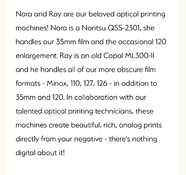I do understand Blue Moon to be nursing along old minilab machinery that still prints optically.
That sort of machinery was of course typical for much of the market for many years, and when used carefully by knowledgeable people could produce decent volumes of very good quality results. That quality was/is of course not close to what a really good custom printing optical workflow could produce.
A high quality digital intermediary custom line can also produce higher quality than Blue Moon's machine - so much turns on the operators.
However all of those quality approaches to print quality make far more use of the information in a negative than a standard 2K or 4K monitor or projector shows - but as they produce reflective media, they don't produce output with as much "presence". That "presence" tends to make up in impact for the real degradation that does occur due to having to discard so much data in order for an image to display on a monitor or through digital projection. That and the fact that the human eye has limits in what information can actually be perceived - both on a print, and on a screen.
That sort of machinery was of course typical for much of the market for many years, and when used carefully by knowledgeable people could produce decent volumes of very good quality results. That quality was/is of course not close to what a really good custom printing optical workflow could produce.
A high quality digital intermediary custom line can also produce higher quality than Blue Moon's machine - so much turns on the operators.
However all of those quality approaches to print quality make far more use of the information in a negative than a standard 2K or 4K monitor or projector shows - but as they produce reflective media, they don't produce output with as much "presence". That "presence" tends to make up in impact for the real degradation that does occur due to having to discard so much data in order for an image to display on a monitor or through digital projection. That and the fact that the human eye has limits in what information can actually be perceived - both on a print, and on a screen.













